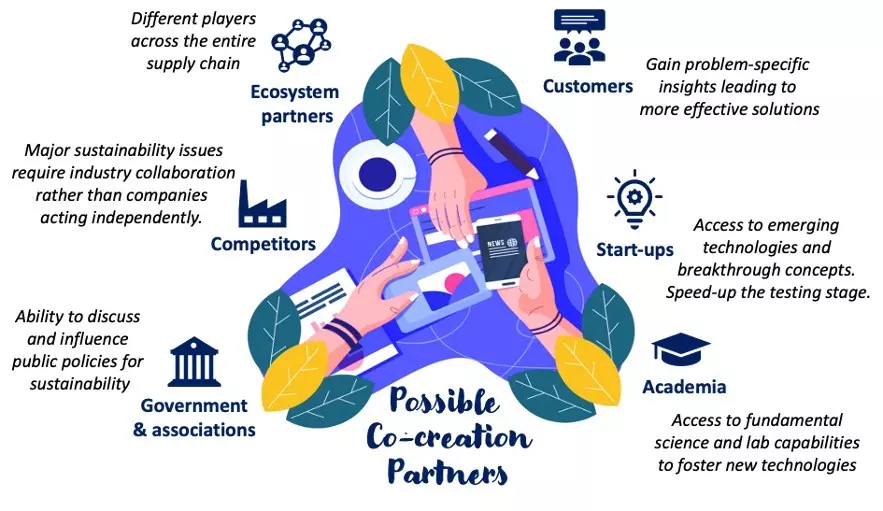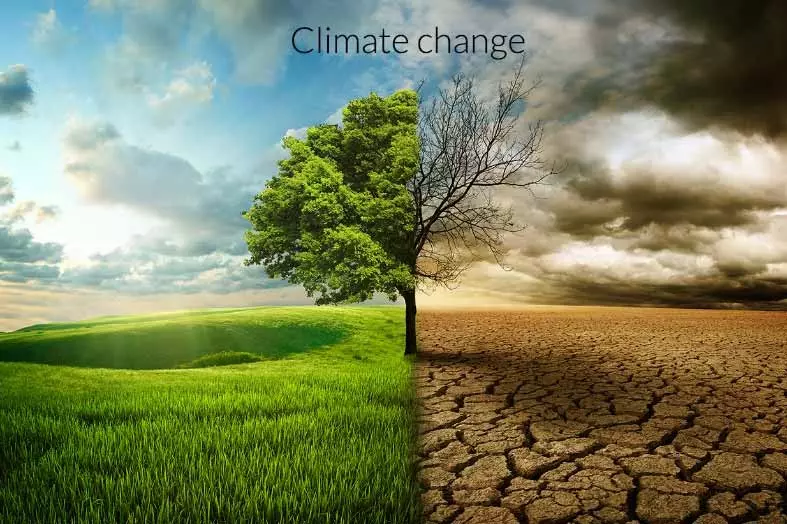Over the years, corporations have heavily relied on their R&D departments to drive and protect product innovation. Sustainability issues have predominantly been addressed through traditional and controlled technological advancements. In more recent years, this approach has become insufficient to meet the new market reality, which shows an increasing customer-centricity demand including cross-business concerns.
In light of this scenario, value co-creation has been gaining momentum to fulfil the new market dynamics. According to the studies of Vargo et al. and Kaushik et al., co-creation can be defined as the integrated framework for thinking and structuring shared value in terms of service, resources, know-how, ideas, etc. exchange through the engagement of various stakeholders aiming a mutually beneficial value for all the parties involved in the process [1, 2].
Whereas corporations should continue investing in robust internal R&D capabilities, today’s oscillating business environment requires that organizations broaden their innovation approaches. Hence the co-creation process arises as a strong methodology that brings several advantages [3], a few of which can be highlighted as follows:
- Faster product market release: product development cycles can be optimized leading to reduced concept-to-launch times.
- Resources diversification and access to other capabilities: broader breadth of expertise and competencies that breed new or enhanced products through partnerships across different players of the value chain.
- Customer intimacy: strengthening of the relationship with customers leading to stronger and longer-term collaborations.
- New business opportunities: exposure to new and/or emerging technologies generating new business models to tackle wicked problems related to sustainability. This has previously been discussed in this article on driving sustainability as a business. Check it out!
- Risk- and cost-sharing: new business models may imply in possible liabilities, which can be minimized or better managed by apportioning the risks involved and their associated costs, e.g. sudden change in market trends or slow product adoption.
- Brand expansion to adjacent markets: co-creation associates may act as a liaison to promote partner’s brand awareness to new consumers closer to their end of the value chain, what could be difficult to take place without a partner.
Now that the importance and gains of co-creation are clear, a new question arises:
With whom should a company consider co-creating?
An effective co-creation process should assess a wide range of stakeholders across the value chain to identify and leverage expertise from different perspectives. The following infographic highlights some of the key partners that could be explored.

Considering a broad spectrum of possible partners, it is crucial to select the ones that have aligned partnership goals, complementary expertise and resources, and reciprocal value proposition. To ensure a solid and fruitful partnership, companies must always ask the following questions:
“What can we offer that the partner needs/wants?
What can we benefit from them?”
These very simple questions are critical to determining the basic principle of shared value. The more mutually beneficial the answers are for the involved parties, the higher is the likelihood of a solid and successful co-creation partnership.
Connecting the value chain becomes crucial to solving systemic sustainability problems. This may also include an unexpected form of partnership, even with competitors that may complement a company’s expertise more than compete.
Is your company willing to collaborate with its competitors
Simon Sinek stated in the book “The infinite game” – I highly recommend it by the way – that competitors must be assessed and ‘worthy rivals’ identified. Sinek defined ‘worthy rivals’ as the other players in the game worthy of comparison to detect your improvement gaps [4].
For the sake of the co-creation process; observing, studying, and collaborating with some of these ‘worthy rivals’ may bring new opportunities to light that will support the resolution of bigger sustainability issues for the whole industry. Without a worthy rival, companies may risk their humility to perceive gaps and miss the chance to increase their agility.
Does your company know its ‘worthy rivals’? Are you ready to learn from them?
Thus, tackling some wicked sustainability problems will certainly require efforts from different fronts, including the collaboration of the whole industry, not only a unilateral corporate view. A systemic change will only occur with the true engagement of different players from across the chain.
A good example of a possible co-creation process is the Design for Recyclability (D4R) for plastic packaging. When discussing package recyclability, a robust and effective process should take into account several aspects such as customer insights through BO experience, converters expertise on machinery and scaling-up challenges, chemical supplier’s base product knowledge on performance, safety, and technical limitations, etc.
This co-creation process should consider not only the technological advancements required but all practical aspects involved to make the case succeed, which can be divided as follows:
- Technical recyclability refers to the feasibility for a package to be technically recycled taking no notice of other factors such as real-world economics, infrastructure, supply, scalability, etc. This relates more to the achievability of technical aspects of the recycling process such as formulation, product performance, toxicology, etc.
- Practical recyclability, conversely, relates to practical to the conditions for a package to get recycled after its disposal by a consumer. This process is heavily subordinated to factors other than technical capacity such as waste stream availability, scalability, reproducibility, society engagement, recycling chain infrastructure, profitable results for stakeholders, stability business model, etc.
A robust co-creation process must consider the distinction between technical and practical recyclability to ensure transparency, avoid misleading understandings, misaligned performance assessment, and continue effective work towards quantifiable results that be mutually understood by all parties.
Thus, D4R is a great example on how complete a co-creation process can be, taking into account not only technical innovation but a comprehensive collaboration with a well-rounded view to optimize processes, methods, technology, infrastructure, suppliers. It is clear that not only different value chain players have critical contributing roles, but the relevance of cross-functional collaboration is also highlighted as the varied functions (R&D, marketing, supply, sales, etc.) provide distinct and enlightening insights to solve the issues.
A dynamic co-creation process can be the catalyst for evolving a company’s strategy whilst nurturing game-changing innovation as the pivotal engine for high-calibre value generation and profitable sustainable growth.
In light of this, the importance/power of partnerships becomes evident for promoting a truly systemic change and enable long-term impactful and sustainable solutions. Co-creation propels new business opportunities, nourishes long-term partnerships, strengthens customer loyalty, and fastens problem-solving through innovation.

On top of all advantages gained throughout the process, there is also the benefit of joint communication of results, which maximize visibility in the industry. Major sustainability issues can only be mitigated or solved at scale based on effective collaboration from different fronts, thus, co-creation can certainly serve as a powerful methodology towards a more sustainable future.
What about you? Will you shrink away from the co-creation challenge?
References
[1] Stephen L. Vargo and Robert F. Lusch, “Service-dominant logic 2025”, International Journal of Research in Marketing (2017).
[2] Arun Kaushik, Amit Agrawal, and Zillur Rahman, “Co-creation of Social Value through Integration of Stakeholders”, Procedia – Social and Behavioral Sciences (2014).
[3] Anne Kwan, Maximilian Schroeck, and Jon Kawamura, “How cocreation is helping accelerate product and service innovation” Deloitte series on digital industrial transformation (2020).
[4] Simon Sinek, “The Infinite Game” Publisher Portfolio (2019).











